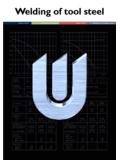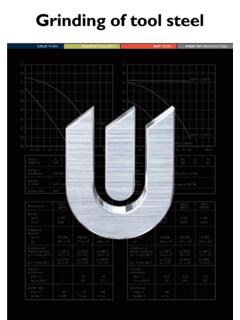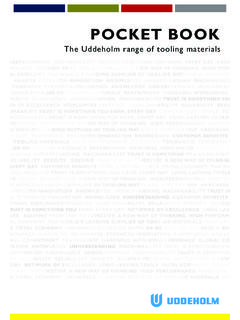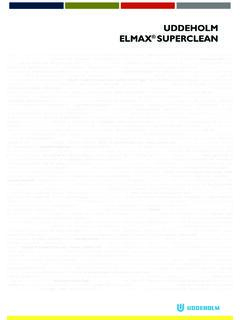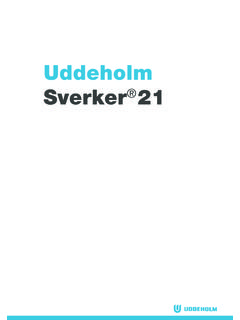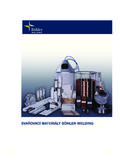Transcription of HOTVAR - Bohler Uddeholm
1 HOTVAR . Hot work tool steel HOTVAR . General Properties HOTVAR is a high performance molybdenum- All specimens are taken from the centre of a bar vanadium alloyed hot-work tool steel which is 115 mm (4,5 ). Unless otherwise is indicated all characterized by: specimens were hardened at 1050 C (1920 F), High hot wear resistance quenched in air and tempered 2 + 2 h at 575 C. (1070 F) to a hardness corresponding to 56 HRC. Very good high temperature properties High resistance to thermal fatigue PHYSICAL DATA. Very good temper resistance Data at room and elevated temperatures. Very good thermal conductivity. Temperature 20 C 400 C 600 C. (70 F) (750 F) (1110 F).
2 Typical C Si Mn Cr Mo V. analysis % 0,55 1,0 0,75 2,6 2,25 0,85 Density kg/m3 7 800 7 700 7 600. Standard lbs/in3 0,281 0,277 0,274. specification None Modulus of Delivery elasticity condition Soft annealed to approx. 210 HB MPa 210 000 180 000 140 000. Colour code Red/brown psi 30,5 x 106 26,1 x 106 20,3 x 106. Coefficient of thermal expansion per C from 20 C 12,6 x 10 6 13,2 x 10 6. IMPROVED TOOLING PERFORMANCE F from 68 F 7,0 x 10 6 7,3 x 10 6. HOTVAR is a specially premium hot work steel Thermal conductivity developed by Uddeholm to provide a very good W/m C 31 33 33. performance in tooling up to 650 C. The alloy Btu in (ft2h F) 215 230 230.
3 Elements in HOTVAR are balanced to give high hot wear resistance and good high temperature properties. HOTVAR is manufactured by special techniques. MECHANICAL PROPERTIES. Approximate tensile strength at room temperature. Applications Hardness Tensile 54 HRC. 2 100 MPa 56 HRC. 2 200 MPa 58 HRC. 2 300 MPa HOTVAR is a hot-work tool steel suitable for appli- strength 136 tsi 142 tsi 149 tsi Rm 305 000 psi 320 000 psi 335 000 psi cations where hot wear and/or plastic deformation are the dominating failure mechanisms. Yield 1 800 MPa 1 820 MPa 1 850 MPa strength 117 tsi 119 tsi 121 tsi Applications and tools of especial interest: Rp0,2 260 000 psi 265 000 psi 270 000 psi Warm forging, dies and punches Roll forging, rolling segments Rock orbital forging, punches and dies Upset forging, clamping tools Progressive forging, dies Axial closed die rolling, top and bottom dies Cross forming, segments Hot bending, tools Hot calibration, tools Zinc die casting, dies Al-tube extrusion.
4 Recommended hardness level is 54 58 HRC. For improving the wear resistance the tools can be Dies for axial closed die rolling. plasma nitrided or nitrocarburized. 2. HOTVAR . Hot strength Effect of time at high temperature on hardness The softening at high temperatures and different Hot strength in longitudinal direction. holding times are shown below. The specimens psi Rm/Rp0,2/MPa have first been hardened and tempered to 54, 56. 1000X Z, A5%. and 58 HRC. 362 2500. Hardness, HRC. 60. Rm 290 2000 55. 50. Rp0,2. 217 1500 45. 550 C. 40 (1020 F). 35. 145 1000 100. 30. 0 1 10 100. Z Time, hours 72 500 50. A5 Hardness, HRC. 60. 0 0 0. 0 200 400 600 800 C 55 600 C.
5 30 390 750 1110 1470 F (1110 F). Temperature 50. 45. 40. Effect of testing temperature on impact energy 35. Charpy -V specimens, transverse direction. Impact energy 30. ft lbs joule 0 1 10 100. Time, hours 15 20. 11 15 Hardness, HRC. 60. 650 C. 55 (1200 F). 7 10. 50. 45. 4 5. 40. 35. 0. 0 100 200 300 400 C 30. 0 1 10 100. 30 210 390 570 750 F Time, hours Testing temperature 3. HOTVAR . Heat treatment Temperature C F. Soaking time*. minutes Hardness before temp. for 25 mm (1 inch). Oil Air general recommen- 1050 1920 30 61 1. 62 1. 59 1. 60 1. dations 1070 1960 20. * Soaking time = time at hardening temperature after the tool is fully heated through.
6 SOFT ANNEALING. Protect the part against decarburization and oxida- Protect the steel and heat through to 820 C. tion during hardening. (1500 F). Then cool in the furnace at 10 C (20 F). per hour to 600 C (1110 F), then freely in air. STRESS RELIEVING QUENCHING MEDIA. After rough machining the tool should be heated High speed gas/circulating atmosphere through to 650 C (1200 F), holding time 2 hours. Vacuum (high speed gas with sufficient positive Cool slowly to 350 C (660 F), then freely in air. pressure). Martempering bath or fluidized bed at 450 . HARDENING 550 C (840 1020 F). Pre-heating temperature: first step at 480 600 C Martempering bath or fluidized bed at approx.
7 (895 1110 F), second step at 850 C (1560 F). 180 220 C (360 430 F). Austenitizing temperature: 1050 1070 C (1920 Warm oil, about 80 C (175 F). 1960 F), normally 1050 C (1920 F) but when Note. 1: Temper the tool as soon as its tempera- maximum hardness is required the normally tem- ture reaches 50 70 C (120 160 F). perature is 1070 C (1960 F). Note. 2: In order to obtain the optimum properties for the tool, the cooling rate should be fast but not at a level that gives excessive distortion or cracks. CCT -graph Austenitizing temperature 1050 C (1920 F). Holding time 30 minutes. F C. 2000 1100. 1800 1000. Ac1. 900 =A890 C. C1 = 890 C (1630 F). 1600 (1630 F).
8 AAc1s = 800 C (1470 F). 800 C1s 1400 = 800 C. (1470 F). 700 Pearlite 1200 Cooling Carbides 600 curve Hardness T800 500. No. HV10 (sec). 1000. 500 1 772 1. 800 2 734 140. 400 3 715 280. 600 Bainite 4 707 450. 300. Ms 5 690 630. 400 200 6 548 1390. Martensite 7 473 5215. 200 100 Mf 8 464 8360. 1 2 3 6 7 8 9. 4 5. 9 351 19400. 1 10 100 1 000 10 000 100 000 Seconds 1 10 100 1000 10 000 100 000 Seconds 1 10 100 1 000 Minutes 1 10 100 1000 Minutes 1. 1 10. 10 100. 100 Hours Hours AirAir cooling cooling of of bars 0,2 1,5 10. 10 90. 90 600 mm 600 bars, mm inch 0,008 0,06 0,4 3,6 23,5 inch 4. HOTVAR . Hardness, grain size and retained austenite as func- DIMENSIONAL CHANGES DURING.
9 Tion of austenitizing temperature. HARDENING AND TEMPERING. Samples 25 mm (1 inch). During hardening and tempering the die is ex- Grain posed to thermal as well as transformation size ASTM stresses. This will inevitably result in dimensional Hardness, HRC Retained austenite %. changes and in the worse case distortion. It is 10 64. Grain size therefore recommended to always leave enough machining allowance after machining before the 8 62. HRC Oil die is hardened and tempered. Normally the size in the largest direction will shrink and the size in the HRC Air 6 60 smallest direction might increase, but this is also a 6. matter of the die size, the die design as well as the Retained austenite cooling rate after hardening.
10 4 58 4. For HOTVAR it is recommend to leave a machin- ing allowance of 0,4 per cent of the dimension in 2 56 2 length, width and thickness. 0 54 0. 1050 1060 1070 1080 C NITRIDING AND NITROCARBURIZING. 1920 1940 1960 1980 F. Nitriding and nitrocarburizing result in a hard Austenitizing temperature surface layer which is very resistant to wear and erosion. The nitrided layer is, however, brittle and may crack or spall when exposed to mechanical or TEMPERING thermal shock, the risk increases with layer thick- ness. Before nitriding, the tool should be hardened Choose the tempering temperature according to and tempered at a temperature at least 50 C.


